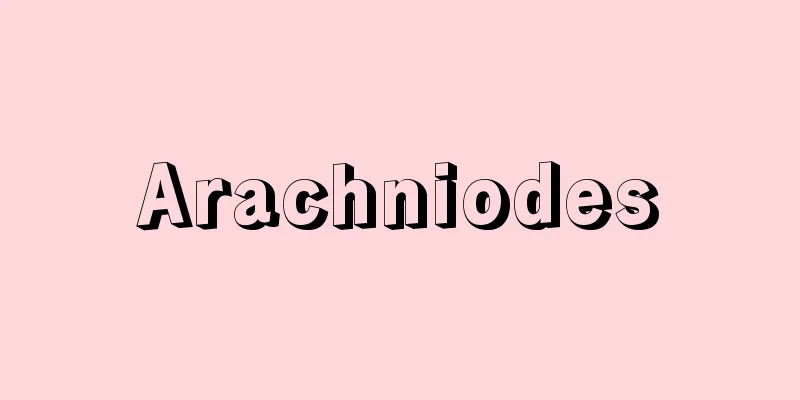Handicraft - Shugei

|
It refers to arts and crafts done with the hands, such as embroidery and knitting. [Kumiko Ichikawa] historyHandicrafts must have arisen spontaneously out of the needs of human daily life, just like other crafts. They started out as a way to reinforce and repair clothing, using animal or fish bones as needles to sew together the two ends of a piece of cloth or to layer it in two. They also cut the ends of leather to make fringes, and cut leftover cloth into small pieces to make threads that they could knit or tie. We can infer from excavated remains that handicrafts were practiced in ancient Egypt and Babylonia. Japanese handicrafts were introduced into school education (ordinary elementary schools) in 1872 (Meiji 5) when the school system was promulgated, but in girls' schools, Western embroidery and Western knitting were taught in 1870 at what is now Ferris Girls' School in Yokohama. At that time, sewing (Japanese clothing) was an important part of the curriculum. Handicrafts were not explicitly stated as a subject or part of it until 1895, when Western handicrafts were also included in the curriculum. As clothing became more westernized, the content of handicrafts changed, and after World War II, the number of dressmaking schools increased, and from 1976 (Showa 51) the number of dressmaking vocational schools also increased, and clothing handicrafts were incorporated into dressmaking education. Currently, it is included in the curriculum as part of home economics education in general education from elementary school onwards, and it is also included as a specialized subject in junior colleges and home economics departments at universities. [Kumiko Ichikawa] kindsThere are many crafts, including embroidery, knitting, dyeing, lace, artificial flowers, beads, weaving, hat making, leather crafts, nut crafts, bamboo crafts, thread crafts, string crafts, doll crafts, bags, and stuffed toys, but they can be broadly divided into two categories. (1) Clothing crafts It plays an indispensable and important role in clothing construction, and adds accents to clothing. It often uses various embroidery, lace and knitting techniques. It can also be used for clothing. (2) Interior Decorative Crafts Interior spaces are decorated using various craft techniques, and decorations such as tablecloths combine practical and decorative purposes. Whether it be clothing crafts or interior decoration crafts, sometimes combined with machine-made items, handicrafts continue to exist as the most aesthetic art of daily life. [Kumiko Ichikawa] [Reference] |Source: Shogakukan Encyclopedia Nipponica About Encyclopedia Nipponica Information | Legend |
|
刺しゅうや編物など、手先でする技芸をいう。 [市川久美子] 歴史手芸は、人類の日常生活の必要性から自然発生的におこったはずで、これはほかの工芸と同じである。衣服の補強や修理に端を発し、動物や魚類の骨を針として用い、布の両端を縫い合わせたり、2枚に重ねたりすることから始まった。また、皮革の端を切ってフリンジをつくったり、残り布を細かく切って糸状にし、編んだり結んだりして用いた。古代エジプトやバビロニアなどで行われていたことは、その発掘物から推察することができる。 日本の手芸が学校教育(尋常小学校)に取り入れられたのは1872年(明治5)学制頒布のときであるが、女学校では1870年に横浜の現在のフェリス女学院が西洋刺しゅう、西洋編物を教授したのが始まりである。当時は裁縫(和服)が重要な部分を占めていた。手芸が教科として、またその一部分として明示されたのは1895年のことで、このとき西洋手芸も課するようになった。やがて服装が洋風化したことによって手芸の内容も変化し、第二次世界大戦後、洋裁学校が増加し、1976年(昭和51)から洋裁専門学校の設立も増え、服飾手芸が洋裁教育に取り入れられている。また現在では一般教育でも、小学校から家庭科教育の一環としてカリキュラムに組まれており、専門科目として短期大学や大学の家政学部教育にも及んでいる。 [市川久美子] 種類刺しゅう、編物、染色、レース、造花、ビーズ、織物、製帽、皮革手芸、木の実手芸、竹手芸、糸手芸、紐(ひも)手芸、人形手芸、袋物、縫いぐるみなどがあるが、大別すると二つに分けられる。 (1)服飾手芸 被服構成には欠かすことのできない重要な役割をもち、衣服にアクセントをつける。種々の刺しゅう、レースなど編む技法を用いることも多い。衣服に用いることもできる。 (2)室内装飾手芸 室内空間を種々の手芸の技法によって装飾する場合と、テーブルクロスなどのように実用と装飾とを併用した装飾とがある。 服飾手芸、室内装飾手芸とも、場合によっては機械でつくられたものと結び付きながら、手芸品はもっとも審美的な生活芸術として存在し続けている。 [市川久美子] [参照項目] |出典 小学館 日本大百科全書(ニッポニカ)日本大百科全書(ニッポニカ)について 情報 | 凡例 |
<<: Tragopan (English: Tragopan)
Recommend
Cottus kazika (English spelling)
…[Toru Taniuchi]. … *Some of the terminology that...
Kabikankan Mukundaram - Kabikankan Mukundaram
...The Immortal Life of Choitonna by Kṛṣṇadās, a ...
Tomojiro Ikeuchi - Tomojiro Ikeuchi
1906-1991 A composer from the Showa period. Born ...
Tosashimizu [city] - Tosashimizu
A city in the southwest of Kochi Prefecture. It wa...
Permanent shaft coupling
…When these machines are used in combination, it ...
Mediastinum testis (English spelling) mediastinumtestis
…Each is a flattened ellipsoid about the size of ...
Aoyagi Bridge - Aoyagi Bridge
...This bridge was built at a key transportation ...
Browning, John Moses
Born January 23, 1855 in Ogden, Utah, USA. [Died] ...
Parting of the Nanbuzaka Snow - Parting of the Nanbuzaka Snow
This is a story from rakugo and rakugo. Originally...
Clownfish - anemonefish
A general term for marine fish of the family Poma...
Anorthite - anorthite
Anorthite is one of the six types of plagioclase,...
Hakumai Castle
This is one of the legends about the fall of a ca...
Prabhākara - Prabhākara (English spelling)
Date of birth and death unknown. A thinker of the...
Montand - Yves Montand
French chanson singer and film actor. Born in Mon...
Lykeion
…Generally, kinesis is the transition from potent...









